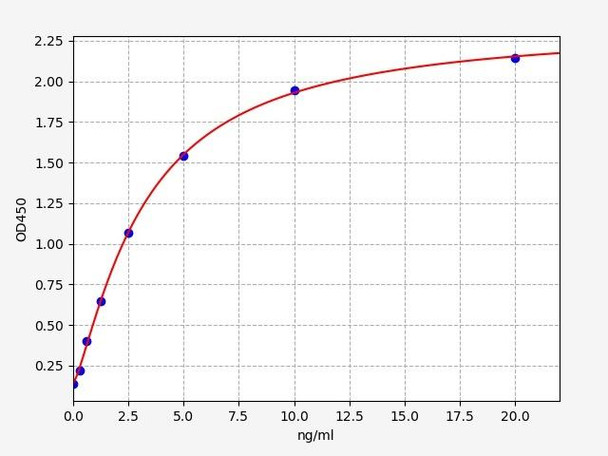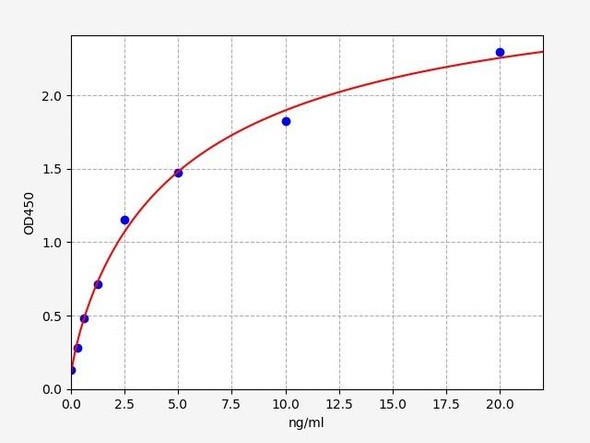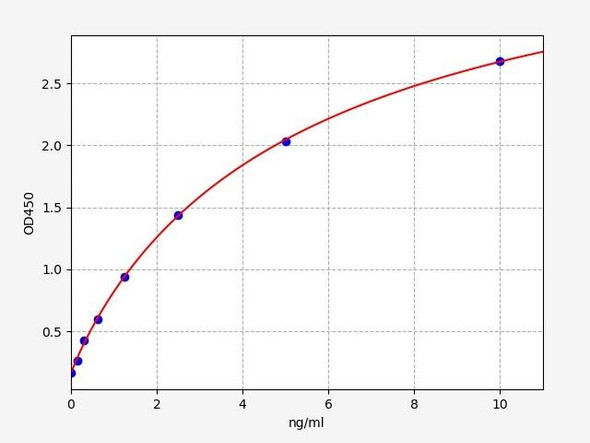Human LDL R / LDL Receptor ELISA Kit (HUFI00868)
- SKU:
- HUFI00868
- Product Type:
- ELISA Kit
- Size:
- 96 Assays
- Uniprot:
- P01130
- Sensitivity:
- 0.188ng/ml
- Range:
- 0.313-20ng/ml
- ELISA Type:
- Sandwich
- Synonyms:
- LDLR, Low-density lipoprotein receptor, FH, FHC, LDL receptor, LDLCQ2, low density lipoprotein receptor, low-density lipoprotein receptor class A domain-containing protein 3
- Reactivity:
- Human
- Research Area:
- Metabolism
Description
Human LDL R/LDL Receptor ELISA Kit
The Human LDL-R (LDL Receptor) ELISA Kit is a reliable and accurate tool for measuring LDL receptor levels in human serum, plasma, and cell culture supernatants. This kit boasts high sensitivity and specificity, ensuring precise and reproducible results for a variety of research applications.The LDL receptor is a key player in cholesterol metabolism, responsible for regulating the uptake of LDL cholesterol from the bloodstream.
Dysregulation of LDL receptor function is associated with a number of cardiovascular diseases, making it a valuable biomarker for studying these conditions and exploring potential therapeutic interventions.With its ease of use and proven performance, the Human LDL-R ELISA Kit is an indispensable resource for researchers seeking to unravel the complexities of LDL receptor biology and its implications for human health.
| Product Name: | Human LDL R / LDL Receptor ELISA Kit |
| Product Code: | HUFI00868 |
| Size: | 96 Assays |
| Alias: | LDLR, Low-density lipoprotein receptor, FH, FHC, LDL receptor, LDLCQ2, low density lipoprotein receptor, low-density lipoprotein receptor class A domain-containing protein 3 |
| Detection method: | Sandwich ELISA, Double Antibody |
| Application: | This immunoassay kit allows for the in vitro quantitative determination of Human LDLR concentrations in serum plasma and other biological fluids. |
| Sensitivity: | 0.188ng/ml |
| Range: | 0.313-20ng/ml |
| Storage: | 4°C for 6 months |
| Note: | For Research Use Only |
| Recovery: | Matrices listed below were spiked with certain level of Human LDLR and the recovery rates were calculated by comparing the measured value to the expected amount of Human LDLR in samples. | ||||||||||||||||
| |||||||||||||||||
| Linearity: | The linearity of the kit was assayed by testing samples spiked with appropriate concentration of Human LDLR and their serial dilutions. The results were demonstrated by the percentage of calculated concentration to the expected. | ||||||||||||||||
| |||||||||||||||||
| CV(%): | Intra-Assay: CV<8% Inter-Assay: CV<10% |
| Component | Quantity | Storage |
| ELISA Microplate (Dismountable) | 8×12 strips | 4°C for 6 months |
| Lyophilized Standard | 2 | 4°C/-20°C |
| Sample/Standard Dilution Buffer | 20ml | 4°C |
| Biotin-labeled Antibody(Concentrated) | 120ul | 4°C (Protect from light) |
| Antibody Dilution Buffer | 10ml | 4°C |
| HRP-Streptavidin Conjugate(SABC) | 120ul | 4°C (Protect from light) |
| SABC Dilution Buffer | 10ml | 4°C |
| TMB Substrate | 10ml | 4°C (Protect from light) |
| Stop Solution | 10ml | 4°C |
| Wash Buffer(25X) | 30ml | 4°C |
| Plate Sealer | 5 | - |
Other materials and equipment required:
- Microplate reader with 450 nm wavelength filter
- Multichannel Pipette, Pipette, microcentrifuge tubes and disposable pipette tips
- Incubator
- Deionized or distilled water
- Absorbent paper
- Buffer resevoir
| Uniprot | P01130 |
| UniProt Protein Function: | LDLR: Binds LDL, the major cholesterol-carrying lipoprotein of plasma, and transports it into cells by endocytosis. In order to be internalized, the receptor-ligand complexes must first cluster into clathrin-coated pits. In case of HIV-1 infection, functions as a receptor for extracellular Tat in neurons, mediating its internalization in uninfected cells. Defects in LDLR are the cause of familial hypercholesterolemia (FH); a common autosomal semi- dominant disease that affects about 1 in 500 individuals. The receptor defect impairs the catabolism of LDL, and the resultant elevation in plasma LDL-cholesterol promotes deposition of cholesterol in the skin (xanthelasma), tendons (xanthomas), and coronary arteries (atherosclerosis). Belongs to the LDLR family. 4 isoforms of the human protein are produced by alternative splicing. |
| UniProt Protein Details: | Protein type:Receptor, misc.; Membrane protein, integral; Cell surface Chromosomal Location of Human Ortholog: 19p13.2 Cellular Component: apical part of cell; basolateral plasma membrane; cell surface; coated pit; early endosome; endosome membrane; external side of plasma membrane; Golgi apparatus; integral to plasma membrane; late endosome; lysosome; membrane; plasma membrane; receptor complex Molecular Function:clathrin heavy chain binding; glycoprotein binding; identical protein binding; low-density lipoprotein receptor activity; protease binding; protein binding; receptor activity; very-low-density lipoprotein receptor activity Biological Process: cholesterol absorption; cholesterol homeostasis; cholesterol transport; endocytosis; lipid metabolic process; phospholipid transport; receptor-mediated endocytosis Disease: Hypercholesterolemia, Familial |
| NCBI Summary: | The low density lipoprotein receptor (LDLR) gene family consists of cell surface proteins involved in receptor-mediated endocytosis of specific ligands. Low density lipoprotein (LDL) is normally bound at the cell membrane and taken into the cell ending up in lysosomes where the protein is degraded and the cholesterol is made available for repression of microsomal enzyme 3-hydroxy-3-methylglutaryl coenzyme A (HMG CoA) reductase, the rate-limiting step in cholesterol synthesis. At the same time, a reciprocal stimulation of cholesterol ester synthesis takes place. Mutations in this gene cause the autosomal dominant disorder, familial hypercholesterolemia. Alternate splicing results in multiple transcript variants.[provided by RefSeq, Sep 2010] |
| UniProt Code: | P01130 |
| NCBI GenInfo Identifier: | 126073 |
| NCBI Gene ID: | 3949 |
| NCBI Accession: | P01130.1 |
| UniProt Secondary Accession: | P01130,Q53ZD9, Q59FQ1, Q9UDH7, B4DII3, B4DJZ8, B4DR00 B4DTQ3, C0JYY8, H0YLU8, H0YNT7, |
| UniProt Related Accession: | P01130 |
| Molecular Weight: | 82,255 Da |
| NCBI Full Name: | Low-density lipoprotein receptor |
| NCBI Synonym Full Names: | low density lipoprotein receptor |
| NCBI Official Symbol: | LDLR |
| NCBI Official Synonym Symbols: | FH; FHC; LDLCQ2 |
| NCBI Protein Information: | low-density lipoprotein receptor |
| UniProt Protein Name: | Low-density lipoprotein receptor |
| Protein Family: | LDLR chaperone |
| UniProt Gene Name: | LDLR |
| UniProt Entry Name: | LDLR_HUMAN |
*Note: Protocols are specific to each batch/lot. For the correct instructions please follow the protocol included in your kit.
Before adding to wells, equilibrate the SABC working solution and TMB substrate for at least 30 min at 37°C. When diluting samples and reagents, they must be mixed completely and evenly. It is recommended to plot a standard curve for each test.
| Step | Protocol |
| 1. | Set standard, test sample and control (zero) wells on the pre-coated plate respectively, and then, record their positions. It is recommended to measure each standard and sample in duplicate. Wash plate 2 times before adding standard, sample and control (zero) wells! |
| 2. | Aliquot 0.1ml standard solutions into the standard wells. |
| 3. | Add 0.1 ml of Sample / Standard dilution buffer into the control (zero) well. |
| 4. | Add 0.1 ml of properly diluted sample ( Human serum, plasma, tissue homogenates and other biological fluids.) into test sample wells. |
| 5. | Seal the plate with a cover and incubate at 37 °C for 90 min. |
| 6. | Remove the cover and discard the plate content, clap the plate on the absorbent filter papers or other absorbent material. Do NOT let the wells completely dry at any time. Wash plate X2. |
| 7. | Add 0.1 ml of Biotin- detection antibody working solution into the above wells (standard, test sample & zero wells). Add the solution at the bottom of each well without touching the side wall. |
| 8. | Seal the plate with a cover and incubate at 37°C for 60 min. |
| 9. | Remove the cover, and wash plate 3 times with Wash buffer. Let wash buffer rest in wells for 1 min between each wash. |
| 10. | Add 0.1 ml of SABC working solution into each well, cover the plate and incubate at 37°C for 30 min. |
| 11. | Remove the cover and wash plate 5 times with Wash buffer, and each time let the wash buffer stay in the wells for 1-2 min. |
| 12. | Add 90 µl of TMB substrate into each well, cover the plate and incubate at 37°C in dark within 10-20 min. (Note: This incubation time is for reference use only, the optimal time should be determined by end user.) And the shades of blue can be seen in the first 3-4 wells (with most concentrated standard solutions), the other wells show no obvious color. |
| 13. | Add 50 µl of Stop solution into each well and mix thoroughly. The color changes into yellow immediately. |
| 14. | Read the O.D. absorbance at 450 nm in a microplate reader immediately after adding the stop solution. |
When carrying out an ELISA assay it is important to prepare your samples in order to achieve the best possible results. Below we have a list of procedures for the preparation of samples for different sample types.
| Sample Type | Protocol |
| Serum | If using serum separator tubes, allow samples to clot for 30 minutes at room temperature. Centrifuge for 10 minutes at 1,000x g. Collect the serum fraction and assay promptly or aliquot and store the samples at -80°C. Avoid multiple freeze-thaw cycles. If serum separator tubes are not being used, allow samples to clot overnight at 2-8°C. Centrifuge for 10 minutes at 1,000x g. Remove serum and assay promptly or aliquot and store the samples at -80°C. Avoid multiple freeze-thaw cycles. |
| Plasma | Collect plasma using EDTA or heparin as an anticoagulant. Centrifuge samples at 4°C for 15 mins at 1000 × g within 30 mins of collection. Collect the plasma fraction and assay promptly or aliquot and store the samples at -80°C. Avoid multiple freeze-thaw cycles. Note: Over haemolysed samples are not suitable for use with this kit. |
| Urine & Cerebrospinal Fluid | Collect the urine (mid-stream) in a sterile container, centrifuge for 20 mins at 2000-3000 rpm. Remove supernatant and assay immediately. If any precipitation is detected, repeat the centrifugation step. A similar protocol can be used for cerebrospinal fluid. |
| Cell culture supernatant | Collect the cell culture media by pipette, followed by centrifugation at 4°C for 20 mins at 1500 rpm. Collect the clear supernatant and assay immediately. |
| Cell lysates | Solubilize cells in lysis buffer and allow to sit on ice for 30 minutes. Centrifuge tubes at 14,000 x g for 5 minutes to remove insoluble material. Aliquot the supernatant into a new tube and discard the remaining whole cell extract. Quantify total protein concentration using a total protein assay. Assay immediately or aliquot and store at ≤ -20 °C. |
| Tissue homogenates | The preparation of tissue homogenates will vary depending upon tissue type. Rinse tissue with 1X PBS to remove excess blood & homogenize in 20ml of 1X PBS (including protease inhibitors) and store overnight at ≤ -20°C. Two freeze-thaw cycles are required to break the cell membranes. To further disrupt the cell membranes you can sonicate the samples. Centrifuge homogenates for 5 mins at 5000xg. Remove the supernatant and assay immediately or aliquot and store at -20°C or -80°C. |
| Tissue lysates | Rinse tissue with PBS, cut into 1-2 mm pieces, and homogenize with a tissue homogenizer in PBS. Add an equal volume of RIPA buffer containing protease inhibitors and lyse tissues at room temperature for 30 minutes with gentle agitation. Centrifuge to remove debris. Quantify total protein concentration using a total protein assay. Assay immediately or aliquot and store at ≤ -20 °C. |
| Breast Milk | Collect milk samples and centrifuge at 10,000 x g for 60 min at 4°C. Aliquot the supernatant and assay. For long term use, store samples at -80°C. Minimize freeze/thaw cycles. |






